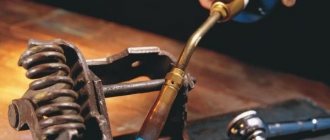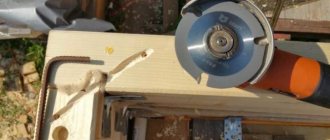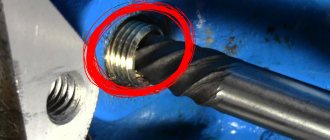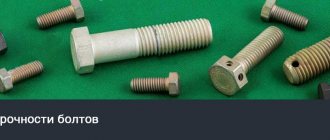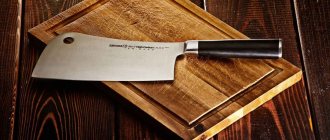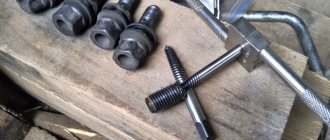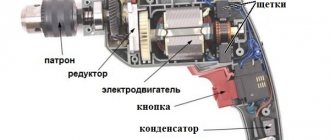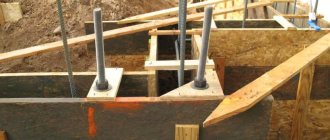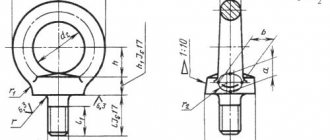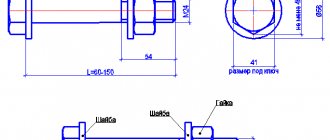This problem often arises when the hex bolt is torn off and it is not possible to unscrew it with a wrench. The causes of this problem may be the sticking effect, displacement of the parts being fastened, over-tightening when installing hex hardware, as well as the use of inappropriately sized keys.
- 1 How to unscrew a hexagon: preparation
- 2 How to unscrew a broken hex bolt
- 3 How to unscrew an internal hexagon with torn edges
- 4 How to unscrew a hexagon without a key
How to unscrew a hexagon: preparation
Whatever the reasons for the situation when the bolt stops unscrewing, the following steps should be taken before plumbing:
- Before unscrewing the hexagon, to reduce the coefficient of friction, it is necessary to open the bolted fasteners with lubricant such as WD-40, kerosene or brake fluid. You can start unscrewing the bolt 30-60 minutes after application.
- A stuck bolt can be gently tapped with a hammer so as not to further disturb the thread.
- If the location of the fastener allows, you can heat it with a gas burner so that the metal becomes more pliable and rust and dirt turn into ash.
Preparatory activities
If the edges are torn off, you can unscrew the bolt only after preparatory work. The work must be carried out without fail, regardless of the reasons that provoked a violation of the integrity of the fastening element.
- It is much easier to remove a damaged bolt or nut if you first apply a penetrating liquid (like WD-40) to the product, which reduces the level of friction. After applying such a solvent to the threads, you can start working in about 1-1.5 hours. It is noteworthy that it is not necessary to use expensive products, since a special penetrating liquid can be replaced with kerosene or brake fluid.
- Before unscrewing a bolt with a torn head, it is necessary to subject it to a certain load, that is, gently tap the stuck fastener with a hammer. As a result of such manipulations, the durability of the bolt will decrease, which will simplify the task of removing it. According to the design, you should not hit it too hard so as not to deform the fastener.
- Depending on the situation and location of the fasteners, you can try to heat the stuck bolts using a gas torch. This will remove rust and dirt, turning it into ash, and will also warm up the metal and make it more pliable. You can also use a set of spanners, a grinder, a file or a welding machine.
It is quite good if there is space near the problematic connections, thanks to which you can use an adjustable wrench or pliers when unscrewing. It is important to take care of the condition of the auxiliary materials so that they are in good working order, since when working with bad tools the situation can only get worse.
How to unscrew a broken hex bolt
To unscrew a protruding hex or star bolt, you can use the following methods:
Option one
If part of the screw or self-tapping screw protrudes above the surface, you can try to grab this tip with pliers. Experts advise using thin-nose pliers, known as duckbill pliers. Then, by rotating counterclockwise, pull out the fastener.
However, if the screw or self-tapping screw is screwed in deeply, there is simply nothing to grab onto. In this case, you will have to touch the surface into which the fastener is screwed. Yes, it will be damaged and will have to be fixed later. But sometimes there is simply no other choice.
If a self-tapping screw or shurpa is screwed into a tree, you can get to it using a chisel. In the case of a concrete surface, you can shallowly drill the surface nearby or make cuts with a grinder to be able to grab the fasteners with pliers or pliers.
If you used a metal self-tapping screw, all that remains is to make additional holes nearby so that the platypuses can get to it.
Let's assume that the head on the self-tapping screw or screw remains, but the slot is torn off, as many craftsmen say - “licked”, rolled. A screwdriver or drill simply breaks off such fasteners. The easiest way to deal with this problem is to use a piece of rubber or any rubberized material. For example, a medical tourniquet or a bicycle tube would be suitable. We cut out a small rectangular or square piece from the material and place it on the head of the fastener with the broken thread. Then we rest against it with a screwdriver and begin to carefully unscrew it. The rubber creates additional grip, the metal screwdriver no longer comes off the slippery metal head and does its job. If the rubber was damaged or torn during operation, just take a new piece and continue unscrewing.
How to unscrew nuts
It is not recommended to use a Torx with a hole in the center; the sprocket can break off.
How to unscrew an internal hexagon with torn edges
To unscrew a bolted connection with a through hole, you can use a file. With its help, the hexagonal hardware is bored to the next size and unscrewed with a wrench.
The second way is to use Torx. They can punch out new splines and reuse the hex hardware, but subsequently it can only be unscrewed with a Torx sprocket.
In addition, before unscrewing the torn hexagon, you can saw through the internal axis of the hexagonal fastener for a screwdriver and unscrew it. With this method, it is not always convenient to get to the fastener; sometimes its location does not allow the use of a screwdriver.
How to unscrew a hex without a key
Other ways to unscrew a bolt without a hexagon are as follows:
When purchasing a set of tools in a case, many buyers paid attention to the strange heads with rounded edges and the Super Lock inscription on the price tag.
Super Lock socket technology has different names among manufacturers: NON SLIP, SURFACE DRIV, BOLT GRIP, SL sockets, sockets with reverse spiral grooves. The appearance of the heads is shown in the figure below.
How to unscrew a licked screw?
First method: use a tourniquet
We place a tourniquet under a screwdriver or a bit and insert it all into the licked head. Next, with simultaneous pressure and a rotational movement, we try to unscrew the screw.
With the right amount of force, you can unscrew the screw with a significant screw-in force.
Method two: how to remove a screw using an impact screwdriver
Of course, the screw cannot be completely unscrewed, but the connection can be loosened significantly, and then we use a regular screwdriver.
Third method: use a special bit for bolts with ground crosses
We insert it into a screwdriver or screwdriver and unscrew it. Sharp edges at the right angle engage perfectly and the screw can be rotated.
Fourth method: extractor
Fifth method: unscrew with the left drill
Sixth method: use core
The core, due to its sharpness, has good engagement, which means that the screw is more likely to be unscrewed.
Tip 1: How to unscrew the hub nut
Super Lock heads, or Super Lock, are fundamentally different from other profiles and have several secrets in their operation.
Socket heads with a Super Lock profile are fundamentally different from hex sockets in the location where the fastener is captured. While the hex head profile applies maximum force to the corners, Super Lock heads load the edges of the fastener.
Super Lock sockets have the following advantages:
Professionals have noticed that Super Lock socket heads allow maximum force to be applied to fasteners and minimize the risk of deformation or breakage. And with fasteners whose edge corners have already been torn off, the tool copes better than heads with a different profile. Therefore, tool sets with a Super Lock profile are often used by auto repair professionals.
Tool sets in a case with a Super Lock head profile are presented in our store here.
Unscrewing fasteners with broken edges
As a rule, this situation arises when dismantling old building structures located in an open place or when there is a defect in the fasteners. To remove the nut, it is important to choose the right tool and carry out the work correctly. Recommended methods:
- For large bolts that are in the public domain, you can use a chisel; you need to attach it along a tangent line to the head, and then apply several strong blows with a hammer. However, with this method there is a risk of surface damage. In addition, you can use a chisel to make a groove for a slotted screwdriver, and then carefully unscrew the bolt;
- If you have free access to the head, it is convenient to use a universal adjustable wrench. With it you can firmly clamp even a completely deformed head; for small nuts it is best to use a wrench with notches on the working surface - they allow you to achieve better adhesion to the fastener;
- If the edges are not very damaged, it is permissible to use a spanner. It should have 12 edges, so you can achieve closer contact with the metal alloy. The head should be selected a size smaller than the diameter of the bolt;
- Using a file or grinder, you can restore the edges of the fastener, which will allow you to safely use a regular hexagon of a smaller size. There is no need to cut out the entire head; it is enough to form two parallel edges.
If you have welding skills, then a bolt with a deformed surface can be restored. To do this, you need to cut off the head from another screw and then weld it onto the old element. This will allow you to use a regular wrench without any effort or additional tools.
How to unscrew a nut: 55 effective recommendations
How to unscrew the nut? We recommend effective approaches for complex situations and a variety of problems.
In this article we will tell you how to unscrew a stuck nut, a rusty nut, a nut with torn edges or a completely round one. Cases with non-standard nuts - plastic and large - are analyzed separately.
The material also describes the most suitable tool, incl. a special tool professionally used to work with fasteners.
The material is useful for those who intend to unscrew the fasteners of the engine crankshaft, hub, wheel, generator, exhaust manifold, variator and other components and assemblies of a car, motorcycle or other equipment.
The recommendations will also be useful for household use.
How to unscrew a nut
As a rule, nuts are unscrewed with hand tools - spanners or open-end wrenches, heads using a wrench or ratchet. However, problematic situations often occur.
How to unscrew a nut when the nut cannot be unscrewed with a regular tool using the usual application of force? In this situation, you should choose from the available tool the one that suits best:
- thin short open-end wrenches, especially with a too loose (broken) jaw, are the worst option, which is better to abandon immediately in a situation with unscrewing rusty stuck nuts (open-end wrenches will lead to torn edges and further difficulties);
- box wrenches with an extended handle are preferable to open-end wrenches, since they cover the perimeter of the nut more tightly;
- A 6-point socket wrench or socket is preferred over the 12-point version;
- Due to its simplicity and strength, a crank is preferable to a ratchet, because for the latter, the application of increased forces can lead to damage to the mechanism (this is especially true for ratchets with a large number of teeth, each of which is smaller and not so durable);
- an air impact wrench will do a better job than a hand tool;
- in combination with a long wrench or an air impact wrench, the best solution would be the Super Lock head, in which the force is applied not to the corners (edges), but to the planes, which eliminates the licking of the nut edges;
- A torque amplifier (multiplier) will help apply a force to a large stuck nut that is inaccessible using only the physical capabilities of a person.
Which way to unscrew the nut
In the vast majority of cases, the fastener has a right-hand thread direction: you need to unscrew the nut counterclockwise (we look at the nut from the side of the free threaded end of the bolt or stud through which you need to drive the nut).
Accordingly, unscrew the nut with a left-hand thread clockwise.
When deciding which way to unscrew the nut, just look carefully at the fasteners:
- on the side you can see the inclination of the threads at a small angle - unscrew the nut in the direction in which the thread “rises”;
- even if the threaded part is not visible, you can see the desired direction along the end of the nut at the point where the last turn of its internal thread exits.
How to unscrew a stuck nut
In order to unscrew a stuck nut, we recommend performing several preliminary preparatory operations:
- clean the fasteners from rust and dirt with a wire brush;
- tap the nut around with a hammer without damaging its edges and exposed threads.
When deciding how to unscrew a stuck nut, it is necessary to take into account several possible methods, based on the actual condition and availability of fasteners for the tool, the composition and parameters of the existing tool, and the feasibility of destroying the nut itself or the threaded part on which it is fixed.
The following options are available for unscrewing a stuck nut:
- apply heat to the nut (preferably until red and repeatedly);
- apply a penetrating compound (WD-40, liquid wrench or their analogues) into the contact gap between the nut and the thread of the bolt (stud), wait the time required for the product to work (from 20 minutes or more depending on the condition of the fastener and the activity of the product);
- increase the force impact on unscrewing by increasing the lever for applying forces through the use of an extended tool (or an extension attachment on a tool of normal length);
- use a special device - a torque amplifier (another name is a torque amplifier, torque multiplier);
- use a pipe wrench, holding the nut with it and applying force in the direction of unscrewing;
- clamp the nut in a rigidly fixed vice and unscrew it, rotating the entire part or assembly, if possible;
- clamp a small separate vice and try to unscrew the nut with it;
- use a pneumatic impact wrench;
- drill out the threaded rod on which the nut is stuck.
How to unscrew a broken nut
Damage to the edges (their breakdown) causes serious difficulties. There are several main solutions in this case:
- use a Super Lock head (acts on planes, not on edges);
- hold the torn nut in a pipe wrench (in a vice, clamp, pliers, etc.) and unscrew it;
- hammer a suitable larger nut on top of the nut with licked edges, the inner diameter of which allows it to be tightly seated; for additional fixation, drill a recess in the area of contact of the nuts, inserting a metal rod there (a piece of a drill and a piece of nail) as a key to prevent rotation) and unscrew the fastener using a tool that matches the size of the nut of larger diameter with working edges;
- put on a nut of larger diameter, weld both nuts together using a semi-automatic welding machine (covering the thread of the stud or bolt with a tube with a suitable wall thickness), unscrew the large nut together with the welded small one.
How to unscrew a round nut
For round nuts, when the edges are cut and smoothed completely by previous unsuccessful attempts, or the nut was made in this form initially, several approaches can also be applied:
- fit a standard hex nut of larger diameter into tension on it and drill a hole and a key that prevents rotation at the line of their contact and unscrew it using the large nut;
- if the side surface is of sufficient height, use a special tool - a pin driver;
- put a square washer of large thickness (comparable to the height of the nut) on the round nut, cut on one side and with the internal diameter of the washer exactly corresponding to the outer diameter of the round nut, clamp the nut with a pipe wrench or a vice, giving in to compression, the nut in the cut will select a gap until it tightly covers the surface round nut, unscrew the fastener.
Unscrew the broken bolts and nuts
“Licked” edges on bolt heads or nuts are not that uncommon. Excessive forces that we apply when tightening and then when unscrewing often lead to the fact that the boundary between the edges of the bolt is erased. If the bolt does not unscrew, ordinary wrenches are powerless in this case - they simply turn, and the fasteners remain in place.
Torn or licked edges on a nut or bolt prevent it from being unscrewed
There are several ways to unscrew shear bolts and nuts:
- Using a gas adjustable wrench. Due to the ribbed jaws, adjustable degree of “tightening” and a fairly large lever, an adjustable wrench helps in most cases. This tool is not uncommon, so the first thing to do if you need to unscrew fasteners with licked threads is to try this method.
A gas (pipe) wrench is the best tool for loosening nuts
How to use the extractor
If there is a plastic or rubber gasket under the bolt, remove it and try one of the suggested methods again. If you can’t unscrew a bolt with torn edges using all these methods, there is only one thing left: cut off/saw off the head and drill out the pin.
Why do the edges of a screw, screw or bolt lick off?
Licking is the grinding down of the edges of a bolt or a screwdriver slot on the head of a screw, screw or self-tapping screw. Both masters and beginners can encounter this problem. When the edges of the bolt are licked, the key begins to slip on it and it is not possible to unscrew such an element. The slots on the head of screws and screws can become damaged, which also leads to the screwdriver turning and making it impossible to unscrew the damaged fastener.
Reasons why the splines of a screw, a screw or the edge of a bolt or nut can lick off:
- use of worn tools;
- incorrect use of a wrench or screwdriver;
- poor quality fastener.
If a key or screwdriver slips through while unscrewing the fastener, do not panic and need to figure out the reason. Sometimes it is enough to change the screwdriver or wrench to solve the problem immediately.
Licking is the erasing of edges or a slot for a screwdriver.
Rusted nut
Another problem that is familiar to car enthusiasts (and not only) is a rusted nut and/or thread. In this case, you should not make heroic efforts to unscrew the fasteners. Your edges will simply “stick together” and another problem will be added to the boiling thread. If after a couple of attempts you can’t unscrew it, try the following methods one by one:
- Tap the bolt with a wrench. There is a chance that the rust will crack and the nut will be unscrewed.
- Fill the connection with kerosene and wait. It will eat away the rust, after which it will be easier to unscrew the rusted nut. But during this operation you cannot smoke, turn on welding, or be near an open flame.
Not the most elegant, but effective solution
Removers for broken nuts
You can also fight rust with lubricant. Try filling the joint with fluid universal lubricant (available in WD40 cans). After waiting a couple of hours, we try to work with the key. If it doesn’t work, we try other methods one by one.
Using a drill
You can try to drill out the remaining bolt with a drill close in size to the size of the bolt. After drilling, remove the remaining bolt with a screwdriver.
It should be remembered that this type of drilling requires some skill so as not to damage the thread of the hole.
If the described instructions on how to properly unscrew a broken bolt did not help you, then you can use another method.
If the design of the part allows it, then you can drill the place of the broken bolt with a large drill, then cut a new thread of large diameter and tighten a suitable bolt.
If you do not have the ability to tighten a large bolt, then you will have to look in a store or find a mechanic or turner who will make you a bushing with a large outer diameter for a new hole. Will cut a smaller internal thread on the bushing that will fit your design.
On the Internet you can find various photos of broken bolts and advice from various professionals who describe the entire process of unscrewing a particular broken bolt.
This article describes the simplest options you can use to remove a broken bolt. But sometimes bolts or studs break in the most inappropriate places.
To fix this problem, you will most likely have to turn to certain specialists who, due to their professional activities, have a lot of ideas on how to unscrew a broken bolt from any of the most inaccessible places.
Self-tapping screws with stripped splines (asterisk)
If overheated screws are unscrewed/twisted a couple of times, their edges lose their sharpness, the screwdriver turns, but the screw itself remains in place. If it “sits” in wood, plaster, chipboard or other similar, not too hard materials, you can put a thin elastic band (for example, for hair) under the screwdriver. Due to the elastic force, a tighter fit is achieved to the remaining edges, which helps to move the self-tapping screw from its place. Other methods are more “traumatic”:
- Cut grooves inside the “licked” funnel using a flat-head screwdriver and unscrew. This method is quite dangerous: if the walls of the “funnel” are too thin, there is a chance that the screw head will simply crumble from the effort. All that remains is a screw that cannot be unscrewed.
It’s already difficult to unscrew such a self-tapping screw
Unscrew the self-tapping screw with torn edges (cross)
The remains of a bolt or stud without a head can be unscrewed as follows: cut a left-hand thread in the remaining body, drip “moment” glue, screw in the left-hand tap, and leave for an hour. Apply some oil to the main thread and leave for an hour. When the glue sets, unscrew it. If the remains of a self-tapping screw are stuck in the wood, it is easier to seal this hole and install another fastener nearby.
Option four
New edges can be cut on a torn or damaged screw head. Or rather, to deepen previously existing but erased ones. The easiest option is to make one cut using a flat-head screwdriver. To do this, use a grinder, a metal saw, or a Dremel. However, in the case of a self-tapping screw made of hardened metal, this option is problematic. In addition, part of the fastener must protrude above the surface so that the notch can be made.
Apply “Moment” type glue to the damaged head of the self-tapping screw or screw. Wait until it hardens a little, apply a screwdriver to this place and press for about five seconds. The glue will set and the screwdriver will no longer slide off; you can slowly begin to unscrew it.
Use extractor. This is a special tool for unscrewing unruly bolts, but it is also suitable for self-tapping screws. The secret of the extractor is that as it rotates counterclockwise, it grips the fastener more and more, preventing it from being pulled out. But before using the extractor, you should drill a hole in the screw along the vertical axis, where the tool will then be inserted. In the case of a regular screw, this is possible, you just need to choose a thin drill. But it is very difficult to drill a self-tapping screw from hardened steel; the drill will simply go to the side.
Fastening any products with screws is a convenient and reliable way. However, almost everyone who has ever screwed or unscrewed a screw with a semicircular head or a countersunk head from a wall or board has encountered the problem of how to unscrew the screw if the crosspiece for the screwdriver has been torn off. Let's try to figure out how to make unscrewing more effective.
